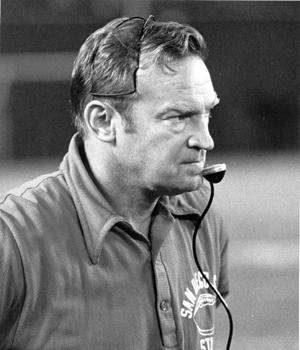In Memoriam: Don Coryell (1924-2010)
A memorial service for former Aztecs football coach Don Coryell is planned for Viejas Arena on Monday, July 12, 2 pm. He died Thursday at the age of 85.

"The Coryell Legacy," reprinted from SDSU Magazine, Summer 2002
By Steve Dolan
Dubbing a new San Diego State football era “Air Craft” is more than coining a clever phrase. For longtime Aztec fans, it harkens back to the heyday of the legendary Don Coryell. Head football coach at SDSU from 1961 through 1972, Coryell won fame for his unbeatable passing offense and his winning seasons. Memories of the “Air Coryell” era at San Diego State still delight fans and former colleagues from Montezuma Mesa and throughout today’s National Football League.
Several of Coryell’s former assistants have gone on to shine as NFL coaches, some even taking their teams all the way to the Super Bowl. Joe Gibbs won three Super Bowl championships as head coach of the Washington Redskins. John Madden took one with the Oakland Raiders. And NFL assistant coaches Jim Hanifan, Rod Dowhower and Ernie Zampese all own Super Bowl rings. Also apprenticing under Coryell at SDSU were longtime NFL assistant coaches Tom Bass and Sid Hall.
Breaking the mold
Former Coryell colleagues believe their mentor’s intensity, devotion to the game and willingness to take risks set an invaluable example for other coaches. “Don was a master at what he did,” said Gibbs, who now owns the Joe Gibbs Racing NASCAR team. “I don’t know if I was ever around anyone who was more dedicated, focused and intense.”
John Madden, a television sports analyst who will soon join ABC’s “Monday Night Football” crew, agrees. “Don Coryell was the originator of focus and a one-track mind,” Madden said. “Football was his life. He gave great pre-game talks. He’d turn out the lights, and when you’d listen as a coach, you were ready to go out there and play.”
How successful was the Coryell coaching formula? His record at SDSU speaks for itself. In 12 seasons with the Aztecs, Coryell won 104 games, lost 19 and tied two. It was a showing that helped him make a career move unheard of at the time: jumping from a small college to the National Football League. Coryell went on to coach 14 successful years in the NFL for the St. Louis Cardinals and the San Diego Chargers, and he remains the only coach ever to win 100 games at both the collegiate and professional levels. In 1999, he was inducted into the College Football Hall of Fame.
Now living in retirement in rural Friday Harbor, Wash., Coryell, 77, says nothing in his long career compared to coaching at SDSU. “My wife and I often talk about how those were the best years of our life,” Coryell said. “I think it was because of the people there. Next to that, it was the university....When I was there, our funds were very limited,” Coryell continued, “[but] I was allowed to do what I wanted and recruit the people I wanted. Everything was perfect.”
Coryell, in fact, delivered two perfect seasons at San Diego State, with his 1966 and 1969 teams finishing 11-0. His 1968 team went 9-0-1, its only “blemish” a 13-13 tie against Tennessee State. The Coryell-era Aztecs posted winning streaks of 31 and 25 games. Only once in 12 years did they lose more than two games in a season.
Pro scouts took notice. Despite San Diego State’s small size at the time, Coryell saw 42 of his players drafted into the NFL. Among them was defensive end Fred Dryer, whose 1967 and 1968 Aztec teams turned in a 19-1-1 overall record. Dryer, also known for his leading role in the television series, “Hunter,” went on to play 13 years in the NFL and was elected to the College Football Hall of Fame in 1997. He credits Coryell for teaching him the right way to play the game.
“When I went to the New York Giants in 1969, I was dismayed at how unsound they were,” Dryer said. “I learned more about defense at San Diego State than I did in my first three years of pro football.”
Innovations in offense
Coryell drew particular notice for his offensive strategy, which literally introduced the modern passing game to college football. Not surprisingly, SDSU quarterbacks Don Horn (1965-66), Dennis Shaw (1968-69) and Brian Sipe (1969-71) all went on to make their marks in pro football. Receivers Gary Garrison (1964-65), Haven Moses (1966-67) and Isaac Curtis (1972) did likewise.
Sipe, who played for the Cleveland Browns from 1974 through 1983 and earned the NFL’s most valuable player award, believes his SDSU career had “everything to do” with his success as a pro. A very low draft pick in the 13th round, Sipe says his SDSU experience in the Coryell offense put him miles ahead of the competition.
“I ran a more sophisticated offense at San Diego State than what the Cleveland Browns had,” said Sipe, now a high school football coach who took Santa Fe Christian to a San Diego County title last fall. “Other quarterbacks were stronger than me. [But] they were not as comfortable as I was in a passing offense.
“What we did at San Diego State is common now,” Sipe went on. “Back then, it was revolutionary. The fans really appreciated it. We even outdrew the Chargers [in attendance] some years.”
Before Coryell came to SDSU, he had concentrated more on running the ball, and even introduced the popular I-formation running attack as an assistant coach at the University of Southern California. In time, a majority of college teams used the same offense, but Coryell was in the vanguard.
“Every place he went, he was a pioneer,” Madden said. “He was an innovator long before he was known as an innovator. He’s a brilliant mind, coach, teacher and motivator.”
A players’ coach
Players and coaches alike describe Coryell as an extraordinary man. They say he was honest, straightforward, dedicated, intense and fun to play for. Tom Nettles, a wide receiver for Coryell at SDSU from 1966 through 1968, remembers him as the ultimate players’ coach.
“I talked to [former Chargers quarterback] Dan Fouts about that, and he said Don was the same way with the Chargers,” said Nettles, now an on-air talent with The Golf Channel. “Don only said good things about his players. He took the blame for a loss and gave credit to the players for a win.”
Today Coryell adds that the overall atmosphere on Montezuma Mesa contributed to his success with the Aztecs. “The faculty at San Diego State was just tremendous when I was there,” he said. “They were interested in the team because we had a bunch of guys who ... were there to get an education and didn’t cause problems. The faculty, administration and everybody else were so helpful. I think our players responded to that because some of them had been to other schools that were not as good to them.”
Coryell won the respect of his assistant coaches not only because of his reputation on the field on game day, but also for his dedication and focus away from practice and games. Joe Gibbs remembers seeing Coryell studying plays in a dark room, not even noticing the lack of light because he was so focused.
“He was so intense,” Gibbs said. “That kind of set him apart from most people.”
Madden remembers a time he was talking to Coryell when the coach pulled an apple out of his desk and started eating it. Madden had to ask why he was munching on an old, half-eaten apple before Coryell noticed as much and threw the fruit away.
Making it fun
Coryell was also a skillful delegator who transferred responsibility to his assistants and let them make decisions without ever second-guessing them. “Don had a lot of camaraderie with his players and coaches,” said Ernie Zampese, who coached under Coryell at SDSU from 1967 through 1972 before later rejoining him in the NFL. “It was fun to be around him. I don’t know what I would have done if not for Don Coryell. I had a wonderful career, and it’s because of him.” Zampese is now a special consultant to the St. Louis Rams.
Jim Hanifan, current offensive line coach for the Rams, worked under Coryell at SDSU in 1972 and also followed him to the pros. “The most enjoyable years of my career were with him,” Hanifan said. “He made it fun. So much of what we do today emulates Don Coryell. He had a tremendous legacy not only at San Diego State, but also in the game of football. I know he’s in the College Football Hall of Fame. He should be in the Pro Football Hall of Fame.”
Rod Dowhower, who retired earlier this year as offensive coordinator of the Philadelphia Eagles, seconded that opinion. Dowhower played for Coryell at SDSU in 1963 and 1964, and later coached under him both at SDSU (1966-1972) and with the St. Louis Cardinals.
“He should be in the NFL Hall of Fame,” Dowhower said. “He’s really innovative. A lot of what’s being done now needs to be credited to Coryell. If you pull out films of our 1966 championship team at San Diego State and what is being done today, there’s probably not a lot of difference. A lot of things Don did at San Diego State were probably before their time.”
With characteristic modesty, Coryell passes the praise for his great success at SDSU to dedicated and skilled players and assistant coaches. “It was just a wonderful bunch of years there,” Coryell concluded. “Every year was a great year.”
Related:President Weber's Statement on the Passing of Don Coryell
Remembering Don Coryell Don Coryell (1924 - 2010)



